To train with VR haptic gloves, you’ll first need to charge and calibrate the devices for your hand size and sensitivity preferences. Connect them to your compatible VR system, then select industry-specific training modules that build muscle memory through immersive tasks. Practice basic movements like gripping and rotating objects before advancing to complex procedures. The gloves provide force, vibration, and motion feedback that mirrors real-world interactions, helping you develop authentic skills faster than traditional methods while tracking your progress through built-in analytics that monitor accuracy and technique.
Understanding VR Haptic Glove Technology and Components

Revolutionary haptic technology transforms how you experience virtual environments by bringing the sense of touch directly to your fingertips. VR haptic gloves like the SenseGlove Nova 2 integrate sophisticated sensors that deliver three distinct types of haptic feedback: force, vibration, and motion.
These components work together to simulate realistic touch sensations when you interact with virtual objects. The gloves’ advanced sensors detect your natural hand movements, translating them into precise digital actions without requiring traditional handheld controllers.
Advanced sensors seamlessly translate natural hand movements into precise digital actions, eliminating the need for traditional controllers.
You’ll experience genuine tactile responses that mirror real-world interactions, creating an immersive experience that engages multiple senses simultaneously. This technology’s accessibility shines through its five-second setup and adjustable sizing, ensuring ideal haptic feedback delivery.
The seamless integration of these components enables you to develop muscle memory and enhance skill retention through realistic training scenarios.
Setting Up Your VR Haptic Gloves for Industrial Training
Proper configuration sets the foundation for effective industrial training with your VR haptic gloves. Start by charging and calibrating your SenseGlove Nova 2 to guarantee accurate haptic feedback during sessions.
Connect the gloves to your VR system, verifying compatibility with your chosen industrial training software for seamless virtual environment interaction.
Customize glove settings based on specific training requirements. Adjust haptic feedback levels to simulate various industrial tasks like assembly or maintenance procedures. This customization guarantees realistic tactile sensations that mirror real-world operations.
Familiarize trainees with the glove’s functionalities, teaching them how to manipulate virtual objects and interpret tactile responses effectively. This enhances engagement and training effectiveness.
Regularly update your training scenarios within the VR system to include new procedures or equipment, keeping your haptic gloves relevant for ongoing industrial training programs.
Calibrating Haptic Feedback Systems for Optimal Performance
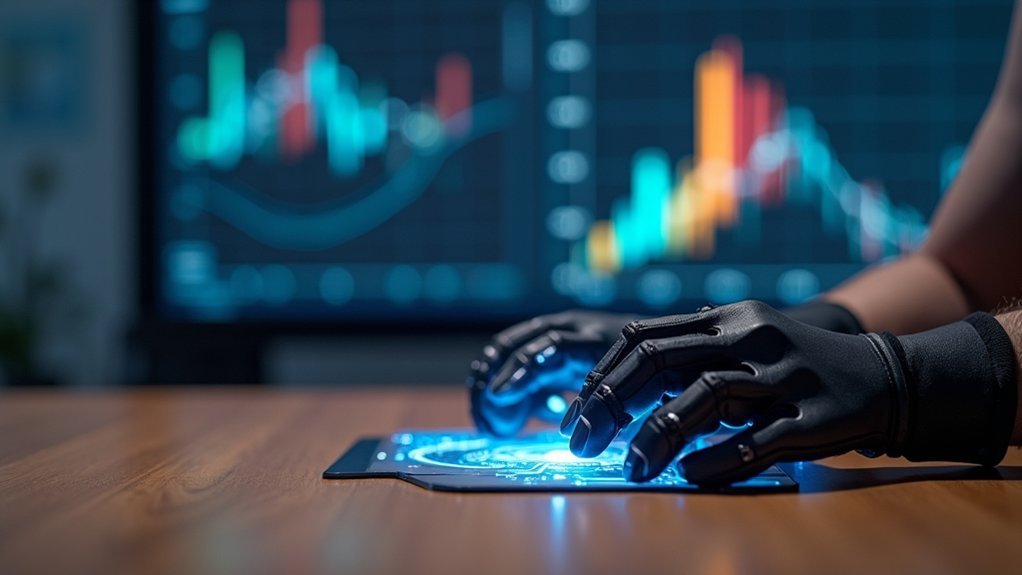
To maximize your VR haptic gloves’ effectiveness, you’ll need to calibrate the feedback systems precisely for each training scenario. Proper calibration guarantees you’ll experience realistic sensations that mirror actual industrial tasks, enhancing your training experiences markedly.
Follow this essential calibration process:
- Initial Setup – Adjust fit and sensitivity settings each time you wear the gloves to accommodate your hand size and specific application requirements.
- Environment Testing – Test gloves across various virtual environments, fine-tuning vibration intensity and resistance to match virtual objects’ physical characteristics.
- Firmware Updates – Regularly update haptic feedback firmware to optimize performance and responsiveness during training sessions.
Incorporate your personal feedback during calibration to better align virtual sensations with real-world tasks, guaranteeing maximum training effectiveness.
Selecting Appropriate Training Modules for Your Industry
Why settle for generic training when industry-specific VR haptic modules can transform your workforce development?
You’ll want to choose training solutions that match your field’s specific needs. Aviation professionals benefit from flight simulation modules, while healthcare workers excel with surgery simulations that provide realistic haptic feedback.
Focus on modules that build muscle memory through immersive experiences, as studies prove this approach markedly improves skill retention.
You should prioritize scalable training solutions that accommodate multiple trainees simultaneously, reducing wait times and maximizing efficiency.
Select modules offering easy updates for new equipment and procedures, keeping your training current and cost-effective.
Industry-specific scenarios with built-in documentation retention help reinforce learning outcomes while tracking progress, ensuring your workforce develops relevant, practical skills.
Mastering Basic Hand Movements and Gesture Controls
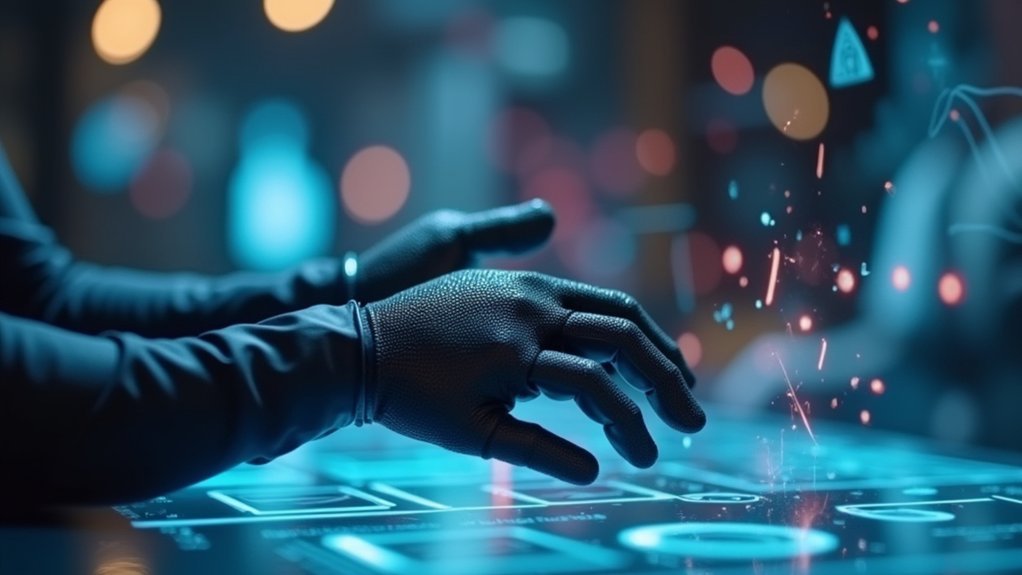
Success with VR haptic training depends on developing fundamental hand coordination skills that translate virtual actions into real-world proficiency.
Mastering fundamental hand coordination in VR haptic training creates the essential bridge between virtual practice and real-world skill development.
You’ll need to master basic movements before advancing to complex tasks. Start by practicing simple hand motions to understand how haptic feedback responds to your actions, creating natural interactions with virtual objects.
Focus on these essential techniques:
- Practice gripping, pointing, and rotating objects using gesture controls to build foundational manipulation skills.
- Perform precision exercises like picking up virtual tools or adjusting panel settings to develop muscle memory.
- Simulate real-world assembly tasks to strengthen the connection between physical movements and haptic feedback.
Regularly increase task complexity to guarantee you’re confidently executing both basic and advanced gestures throughout your training sessions.
Developing Muscle Memory Through Repetitive Virtual Tasks
When you repeat virtual tasks consistently, your hands begin forming automatic movement patterns that transfer directly to real-world situations.
VR haptic gloves accelerate this training process by providing tactile sensations like resistance and texture that reinforce each movement. As you practice precision tasks such as surgical procedures or component assembly, the immersive haptic feedback enhances skill retention considerably.
Studies demonstrate that incorporating these tactile cues into your training improves learning speed and performance in complex tasks. The realistic interactions help you build muscle memory more effectively than traditional methods.
Through frequent practice in virtual environments, you’ll develop higher confidence and proficiency levels. This enhanced muscle memory guarantees you’ll perform better when facing similar real-life situations, making the shift seamless.
Practicing Complex Assembly and Manufacturing Procedures
While traditional manufacturing training requires expensive equipment and materials, VR haptic gloves let you master complex assembly procedures through realistic virtual simulations.
You’ll feel genuine tactile feedback when handling virtual components, experiencing resistance and texture that mirrors real-world materials. This haptic feedback enhances your understanding of intricate processes while building essential muscle memory.
Your VR training system creates immersive environments where you can practice:
- Component handling – Manipulate delicate parts with realistic force feedback
- Assembly sequencing – Learn proper step-by-step procedures for complex assembly tasks
- Quality control – Practice labeling, packaging, and inspection techniques
You’ll acquire skills faster than traditional methods while retaining knowledge longer.
Multiple trainees can practice simultaneously without physical materials, considerably reducing training costs while maintaining safety in controlled virtual environments.
Safety Protocol Training in Virtual Industrial Environments
You’ll master critical safety protocols by training in virtual industrial environments that simulate real workplace hazards without actual risk.
Through VR haptic gloves, you can practice recognizing dangerous situations, executing emergency response procedures, and handling equipment with proper safety techniques.
This immersive approach lets you experience the weight and resistance of industrial tools while learning protocols that’ll keep you safe on the job.
Immersive Hazard Recognition Training
Although traditional safety training relies on classroom lectures and static materials, VR haptic gloves transform hazard recognition into an immersive experience that prepares you for real industrial dangers.
With haptic feedback, you’ll feel equipment vibrations, temperature changes, and material textures that signal potential hazards. This immersive training approach greatly enhances your learning retention compared to conventional methods.
You’ll practice identifying critical safety risks through:
- Equipment malfunction detection – Feel abnormal vibrations and heat signatures that indicate machinery problems
- Unsafe behavior recognition – Experience realistic scenarios where you identify and respond to dangerous workplace practices
- Emergency response simulation – Practice decision-making skills in high-pressure situations without real-world consequences
Multiple trainees can participate simultaneously, making hazard recognition training both scalable and cost-effective while eliminating injury risks.
Emergency Response Procedures
When seconds matter in industrial emergencies, traditional training methods can’t replicate the pressure and physical demands you’ll face during actual crises. VR haptic gloves transform emergency response procedures training by delivering tactile sensations that mirror real-world equipment interactions.
| Training Component | Traditional Method | VR Haptic Enhancement |
|---|---|---|
| Equipment Handling | Classroom demos | Realistic resistance feedback |
| Pressure Response | Role-playing exercises | Immersive stress simulation |
| Skill Retention | Theoretical knowledge | Muscle memory development |
| Decision Speed | Paper scenarios | Real-time virtual challenges |
| Confidence Building | Limited practice | Repeated safe exposure |
You’ll develop faster reaction times through haptic feedback that simulates valve resistance, emergency shut-offs, and equipment weight. This controlled environment lets you practice complex procedures repeatedly, building competence without real-world dangers while adapting to your learning pace.
Equipment Handling Protocols
Since improper equipment handling causes over 40% of industrial accidents, mastering safety protocols through VR haptic gloves becomes critical for protecting both workers and assets.
You’ll experience realistic touch sensations that develop essential muscle memory for safely operating machinery without risking injury or equipment damage.
Your training benefits include:
- Repetitive Practice – You can repeatedly practice safety protocols in controlled virtual environments, improving retention compared to traditional methods.
- Personalized Learning – You’ll adapt scenarios to match your learning pace and specific equipment handling requirements.
- Accelerated Proficiency – Studies show haptic feedback considerably reduces time needed to reach competency levels.
The immersive experience lets you handle virtual tools and machinery with realistic haptic feedback, ensuring you’re fully prepared for real-world industrial environments.
Maintenance and Troubleshooting Skills Development
You’ll develop critical maintenance skills by practicing virtual equipment diagnostics that mirror real-world scenarios without risking costly damage to actual machinery.
The haptic feedback lets you feel component resistance, vibrations, and textures as you troubleshoot complex electrical systems.
You can make mistakes safely in this virtual environment, learning from errors that would be dangerous or expensive in actual maintenance situations.
Virtual Equipment Diagnostics
Although traditional equipment training requires expensive machinery and poses safety risks, VR haptic gloves transform how you’ll develop maintenance and troubleshooting skills by providing realistic tactile feedback without physical constraints.
Virtual equipment diagnostics through haptic feedback enables you to experience authentic sensations when handling components, making your training more effective than theoretical approaches. You’ll diagnose complex issues by feeling vibrations, textures, and resistance that mirror real-world scenarios.
Here’s how virtual equipment enhances your diagnostic capabilities:
- Immediate feedback loops – You’ll receive instant tactile responses when manipulating virtual components, accelerating your learning curve.
- Risk-free repetition – Practice challenging diagnostic procedures multiple times without equipment damage concerns.
- Adaptive scenarios – Experience various equipment failures and malfunctions tailored to your skill level.
This immersive approach guarantees you’ll master diagnostic techniques efficiently while building confidence.
Safe Error Practice
While real equipment maintenance carries significant consequences for costly mistakes, VR haptic gloves create a controlled environment where you can practice complex procedures without fear of damaging expensive machinery or compromising safety protocols.
This safe error practice approach transforms how you develop troubleshooting skills by encouraging experimental learning.
Through haptic feedback, you’ll experience realistic resistance when attempting incorrect procedures, helping you understand why certain approaches fail. You can repeatedly practice challenging scenarios until you master them, learning from each mistake without real-world repercussions.
This freedom to fail safely builds confidence and competence simultaneously.
VR haptic gloves enable you to explore multiple solution paths, test different troubleshooting strategies, and develop intuitive problem-solving abilities that translate directly to actual maintenance situations.
Quality Control and Inspection Techniques Using Haptic Feedback
When quality control demands precision and consistency, VR haptic gloves transform how you’ll master inspection techniques. You’ll experience realistic tactile feedback that simulates examining materials and components for defects, making your training sessions incredibly immersive.
Through haptic feedback, you can practice identifying texture variations, weight inconsistencies, and other quality issues that traditional training methods can’t replicate. This hands-on approach greatly improves your skill retention and real-world inspection accuracy.
Key benefits of VR haptic gloves for quality control training include:
- Repeatable scenarios – Practice identical inspection sequences multiple times without depleting physical resources.
- Scalable training – Multiple trainees can simultaneously learn inspection techniques in virtual environments.
- Enhanced retention – Immersive haptic experiences reinforce proper inspection methods more effectively than conventional training approaches.
You’ll develop consistent, reliable quality control skills that translate directly to manufacturing environments.
Collaborative Team Training in Shared Virtual Workspaces
Since modern workplaces increasingly rely on collaborative efforts, VR haptic gloves revolutionize how teams train together in shared virtual environments.
You’ll experience real-time interaction with virtual objects while developing essential teamwork and communication skills alongside your colleagues.
Collaborative team training using VR haptic gloves creates dynamic learning environments where you can practice simultaneously with multiple participants.
You’ll physically manipulate digital tools while receiving realistic tactile feedback, enhancing retention and performance through this immersive experience.
Your organization can design customized scenarios that mirror real-world teamwork challenges, preparing you for actual workplace collaboration.
Studies show you’ll reach proficiency faster as you learn from teammates and combine skills dynamically.
This technology reduces training time considerably while ensuring you’re better equipped for collaborative tasks in your work environment.
Tracking Progress and Performance Metrics During Training
You’ll gain valuable insights into your training effectiveness through real-time performance analytics that capture every movement and interaction during VR sessions.
The built-in sensors in haptic gloves continuously monitor your accuracy, speed, and technique, providing instant feedback on areas that need improvement.
You can measure your progress against established skill assessment benchmarks, allowing you to see exactly how your performance compares to industry standards and peer levels.
Real-Time Performance Analytics
The integration of real-time performance analytics transforms VR haptic training from simple practice sessions into data-driven learning experiences.
When you’re training with VR, these analytics continuously monitor your performance, tracking essential metrics like reaction time, accuracy, and task completion rates. Your haptic feedback gloves capture detailed data about muscle memory retention, analyzing how quickly you master repetitive tasks.
Real-time performance analytics provide three key advantages:
- Immediate feedback – You’ll receive instant insights about your performance during each session.
- Personalized goal setting – The system establishes customized training objectives based on your progress.
- Trend identification – Analytics reveal patterns in your performance, helping instructors tailor future programs.
You can visualize your improvement through successful virtual object interactions while the system continuously adjusts to foster achievement and maintain motivation throughout your learning curve.
Skill Assessment Benchmarks
Establishing meaningful skill assessment benchmarks requires measuring specific performance indicators that demonstrate your mastery of VR haptic training objectives. You’ll track task completion accuracy and simulation completion times using VR haptic gloves to gauge proficiency levels. Your muscle memory retention becomes measurable through repeated practice sessions, with progress monitored over extended periods.
Haptic technology enables precise measurement of interaction quality and frequency with virtual objects. You can analyze engagement metrics including successful interactions and active participation duration. Regular assessments provide insights into your individual progress, facilitating personalized training adjustments.
| Metric Category | Assessment Method |
|---|---|
| Task Accuracy | Completion precision tracking |
| Time Efficiency | Simulation duration measurement |
| Muscle Memory | Retention through repetition |
| Engagement Level | Interaction frequency analysis |
These skill assessment benchmarks promote ideal development outcomes.
Transitioning Skills From Virtual to Real-World Applications
While mastering skills in virtual environments is impressive, your ultimate goal is applying that expertise in real-world scenarios. VR haptic gloves bridge this gap by providing tactile feedback that develops authentic muscle memory, making shifts smoother and more effective.
The immersive nature of haptic training prepares you for real-world applications through:
- Realistic practice conditions – You’ll experience authentic sensations that mirror actual workplace scenarios.
- Reduced learning curves – Complex tasks become manageable because you’ve already developed the necessary motor skills.
- Enhanced confidence – Repeated virtual practice with tactile feedback builds competence that translates directly to on-the-job performance.
Research consistently shows that haptic-enhanced VR training leads to faster skill acquisition and better retention.
You’ll find yourself performing intricate procedures with greater precision and safety when moving from virtual practice to real-world execution.
Advanced Training Scenarios for Specialized Industrial Operations
You’ll find VR haptic gloves excel in training scenarios where real-world practice isn’t feasible due to safety concerns or equipment costs.
High-risk equipment operations, such as handling hazardous machinery or working with dangerous materials, become accessible through realistic simulations that provide authentic tactile feedback without physical danger.
Complex assembly procedures that require precise manual dexterity and coordination can be practiced repeatedly until you’ve mastered the intricate movements and developed the necessary muscle memory.
High-Risk Equipment Operations
When operating heavy machinery or handling dangerous equipment, even the smallest mistake can result in catastrophic consequences. VR haptic gloves revolutionize high-risk equipment operations training by creating safe learning environments where you can practice without physical dangers.
Through immersive training, you’ll feel realistic resistance and textures that build vital muscle memory. This hands-on approach greatly enhances your ability to operate specialized machinery safely and effectively.
Key benefits of VR haptic training include:
- Tailored scenarios – Practice specific operational challenges and navigate potential hazards safely
- Higher retention rates – Studies show better performance compared to traditional training methods
- Reduced accident rates – Substantially improve safety compliance within industrial environments
You’ll encounter realistic simulations that prepare you for real-world challenges while maintaining complete safety throughout your training experience.
Complex Assembly Procedures
Since complex assembly procedures often require years to master, VR haptic gloves accelerate this learning process by letting you practice intricate tasks without costly materials or equipment downtime.
You’ll feel resistance and texture changes as you manipulate virtual components, developing essential muscle memory for precise assembly work. This haptic feedback simulates real tactile sensations, making you interact with virtual parts as if they’re actual components.
Advanced scenarios accommodate multiple trainees simultaneously, reducing training time while allowing different learning paces.
You’ll engage in hands-on experiences that mirror actual assembly processes without real-world error risks, considerably improving skill retention and performance.
Organizations can easily update training modules with new technologies, ensuring you’re always trained on the latest procedures and equipment in your field.
Frequently Asked Questions
How Do VR Haptic Gloves Work?
VR haptic gloves use sensors to detect your hand movements and activate haptic feedback motors that simulate touch, pressure, and texture when you’re interacting with virtual objects in real-time.
Can VR Be Used for Training?
You can definitely use VR for training in aviation, healthcare, and other complex fields. It’ll improve your practical skills through immersive experiences while reducing costs compared to traditional methods.
What Are Three Disadvantages to VR Training?
You’ll face motion sickness from sensory disconnect, high initial setup costs that strain budgets, and potential over-reliance that limits real-world problem-solving skills development in dynamic environments.
How Much Do Haptic Gloves Cost?
You’ll find haptic gloves like the SenseGlove Nova 2 cost between $3,000 to $10,000 depending on their features and capabilities, but they’ll considerably reduce your overall training expenses.
In Summary
You’ve now mastered the fundamentals of VR haptic glove training. Remember to regularly calibrate your system, practice consistently, and gradually progress through increasingly complex scenarios. Don’t rush the shift to real-world applications – take time to reinforce muscle memory and spatial awareness. Track your performance metrics to identify areas needing improvement. With dedicated practice, you’ll transform virtual skills into tangible expertise that enhances your professional capabilities across various industrial applications.

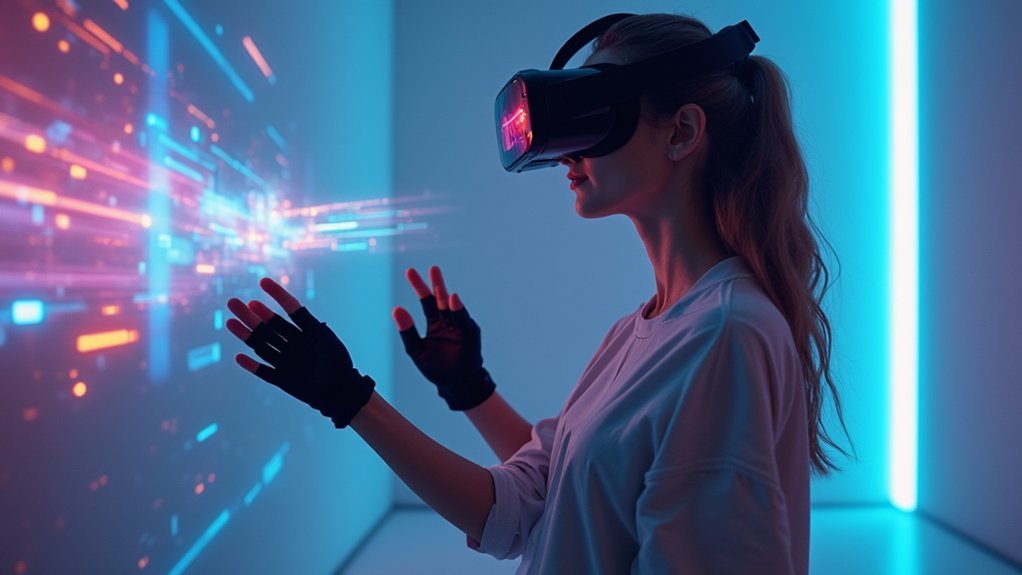
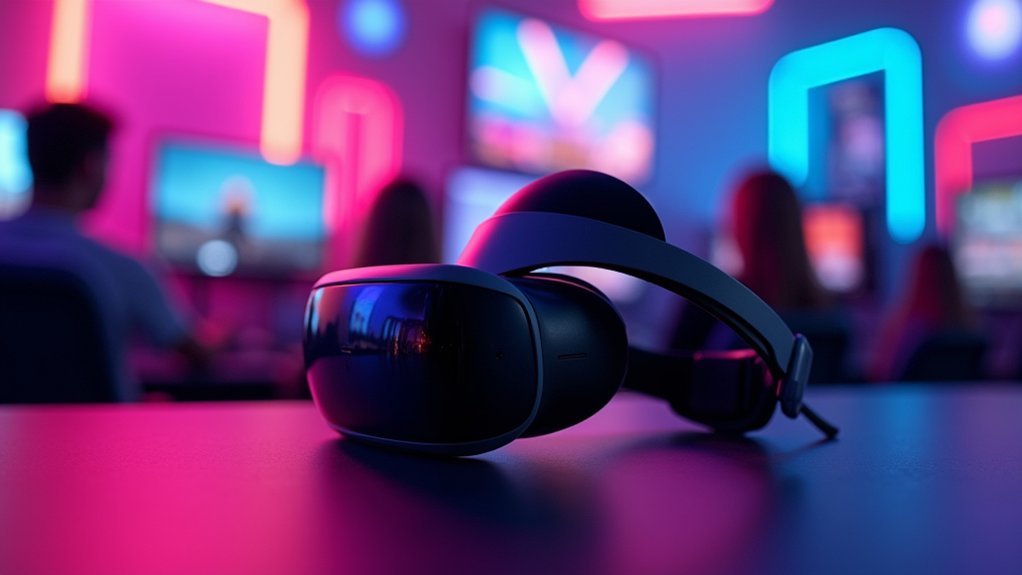
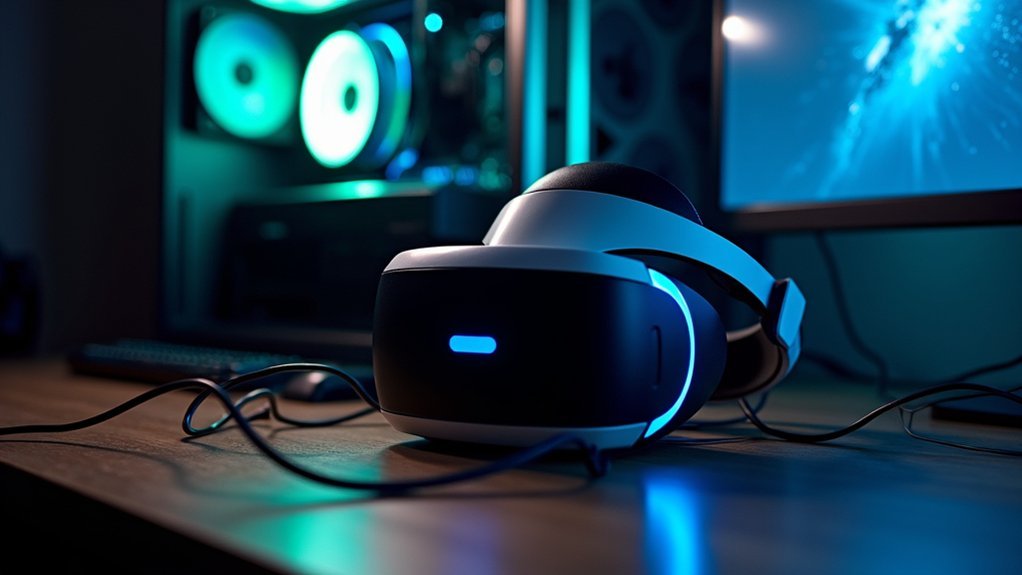

Leave a Reply